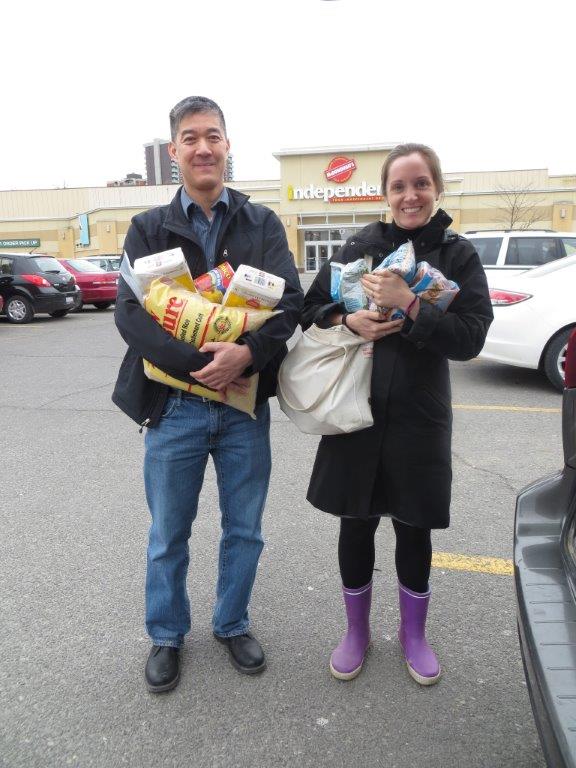All News
Former Prime Minister of Niger Ibrahim Assane Mayaki joins Nutrition International’s Board of Directors
May 8, 2023
Understanding the cycle of poverty and malnutrition $1.75 at a time
I love food and am proud to work for the Micronutrient Initiative - an organization working for the world’s most vulnerable who don’t have access to the nutrition needed to support their health and well being. For this reason – and a few others – I am taking the Live Below the Line Challenge.
Posted on April 24, 2015


I love food and am proud to work for the Micronutrient Initiative – an organization working for the world’s most vulnerable who don’t have access to the nutrition needed to support their health and well being.
For this reason – and a few others – I am taking the Live Below the Line Challenge.
Live Below the Line (or LBL for short) is a global poverty public awareness and fundraising campaign. For five days, from April 27 to May 1, I commit to a budget of $1.75 a day. In doing so, I will give up many of my favourite foods to stay in this budget.
Last year, I participated and I did find ways to stretch the budget, with breakfasts of oatmeal and powdered soy milk, lunches and dinners of rice and beans or lentils and rice. I was also able to afford eggs and a few bananas. Organic coffee and five servings of fruit were out of reach. Over 5 days, my nutritional state was probably relatively unchanged. However, if I had to live within this budget, over the long term I would not be getting the minerals and vitamins that I need to stay healthy, to be productive and engaged in life and at work.
There are over 1 billion people globally who live on $1.75 day for their entire budget, for 365 days a year. No choices over favourite foods. $1.75 for all living costs. Food, clothing, housing, transportation, education, healthcare. $1.75 a day is considered extreme poverty – or living below the poverty line.
Poverty and nutrition are two sides of the same coin. Poverty often determines food choices. Although it is possible to make choices of what foods to buy on a limited budget, many nutritious foods are simply not affordable or accessible. Therefore, food choices – and a lack of choices – really come down to that global issue of food security, which is not only about the issues of available nutritious foods, but also about the worry and burden for families, wherever they live.
The Micronutrient Initiative works to end hidden hunger – the type of hunger where the belly is full but the body is still hungry for nutrition. We work in “high burden” countries, where large numbers of the population live in poverty, and where families struggle to feed their children the food needed to not only survive but to thrive into healthy, productive adults.
In an MI project in Ethiopia, we are working with women’s cooperatives to produce local complementary food for children 6-24 months, a rapid period of growth, using the local crops available.
One mom on her own would find the many steps involved in hand-processing the grains impossibly time consuming, but by forming community cooperatives, the work is reduced for the women involved and they all have access to a complementary food made from a diversity of nutritious grains. This project is improving their food security.
The locally made complementary food is much improved, but not nutritionally complete, so now we have trained health extension workers supporting the women, and other mothers, to add micronutrient powders at home when they feed it to their children. Affordable, accessible and nutritious.
However, poverty, hunger and hidden hunger remain a daily challenge for billions of people around the world. This can be due to ongoing chronic food shortages, a lack of access to a diversity of foods, or it can be the result of conflict or environmental events.
In the dry corridor of Guatemala this past year, there was a looming hunger season, worse than other years; beyond just challenges of access to nutritious food, an absolute food shortage was predicted for many families. Corn stores from the previous year were dwindling and much of the current year’s corn crop was predicted to fail. For families in Sierra Leone, the Ebola outbreak had severe impacts on food security. These are examples of living on $1.75 or less a day. This is food insecurity at its fullest and meanest.
The world is full of examples of how people struggle with poverty, food insecurity and a lack of nutritious food choices. The financial, health and mental health impacts for families are unimaginable.
Living “below the line” for 5 days in a warm house, with a full fridge, a lifetime of vaccines, access to medical care, and a secure job means I won’t be experiencing food insecurity. My goal during the Live Below the Line challenge is to make hidden hunger more visible, engage family, friends, colleagues and neighbours in discussions on what food insecurity means for the many families who have experienced either recent or generations of food insecurity, and the consequences of hidden hunger.
In a food secure world free of hidden hunger, food would nourish growing bodies, feed cultures, and parents would not worry about the next day’s meal.
In the meantime, the nutrient gaps need to be filled with supplementation and fortification so the world’s most vulnerable can have improved health.
For five days, I will think about the billion who live below the line and raise money for Results Canada who keeps the conversation going all year long.
This piece was originally published on The Huffington Post Blog on 23/04/15